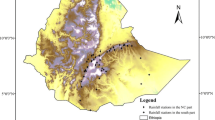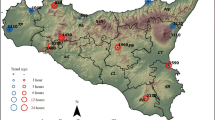Abstract
A high number of studies have detected changes in the observed heavy rainfall in Northern and Central Europe, all adding to the debate on anthropogenic climate change and its potential impact on rainfall extremes. However, it is equally relevant to understand natural variations on which the anthropogenic changes are imposed. This study identifies multi-decadal variations in daily rainfall extremes from Denmark and southern Sweden, with a recurrence level relevant for flood hazard analysis. Based on smoothed series it is concluded that the frequency of the extreme events shows both a general increase from 1874 to present and an oscillation with a cycle of 25–40 years. The magnitude of the extreme events also oscillates, but with a cycle of 15–30 years and a smaller amplitude. Regional analysis of a larger Danish dataset with a shorter observations period found a countrywide low period in 1970–1979. It is furthermore concluded that the oscillation signal along the west coast of Denmark is dominated by the changeable coastal weather of this region. The eastern part of Denmark shows a more consistent signal, which partly can be explained by an index derived from sea level pressure differences between Gibraltar and Haparanda. The identification of a cyclic pattern in the extreme rainfall is highly relevant for our understanding of the non-stationarities in flood hazard.












Similar content being viewed by others
References
Bengtsson L, Rana A (2013) Long-term change of daily and multi-daily precipitation in southern Sweden. Hydrol Process 28(6):2897–2911
Cappelen J. (2013) Denmark—DMI historical climate data collection 1768–2012. Technical report 13-02. Danish Meteorological Institute, Ministry of Climate and Energy. Copenhagen, Denmark
Coles S (2001) An introduction to statistical modeling of extreme values. Springer, London
CRU (2013) North Atlantic Oscillation, Climatic Research Unit, University of East Anglia, Norwich U.K., http://www.cru.uea.ac.uk/cru/data/nao/, Accessed October 2013
Dai A (2013) The influence of the inter-decadal Pacific oscillation on US precipitation during 1923–2010. Clim Dyn 41:633–646
Dingman SL (1994) Physical hydrology. Prentice Hall Upper Saddle River, New Jersey, USA
Enfield DB, Mestas-Nunez AM, Trimble PJ (2001) The Atlantic multidecadal oscillation and its relation to rainfall and river flows in the continental US. Geophys Res Lett 28:2077–2080
Fowler AM, Hennessy KJ (1995) Potential impacts of global warming on the frequency and magnitude of heavy precipitation. Nat Hazards 11:283–303
Frich P, Rosenørn S, Madsen H, Jensen JJ. (1997) Observed precipitation in Denmark, 1961–1990. Technical report 97-8. Danish Meteorological Institute, Ministry of Transport. Copenhagen, Denmark
Gregersen IB, Madsen H, Rosbjerg D, Arnbjerg-Nielsen K (2013a) A spatial and nonstationary model for the frequency of extreme rainfall events. Water Resour Res 49:127–136
Gregersen IB, Sørup HJD, Madsen H, Rosbjerg D, Mikkelsen PS, Arnbjerg-Nielsen K (2013b) Assessing future climatic changes of rainfall extremes at small spatio-temporal scales. Clim Change 118:783–797
Hadley Centre (2013) Hadley centre sea ice and sea surface temperature data set, Met Office Hadley Centre, Exeter U.K., http://www.metoffice.gov.uk/hadobs/hadisst/, Accessed October 2013
Heikkila U, Sorteberg A (2012) Characteristics of autumn-winter extreme precipitation on the Norwegian west coast identified by cluster analysis. Clim Dyn 39:929–939
Helsel DR, Hirsch RM (2002) Statistical methods in water resources. In: U.S. geological survey (ed) Techniques of water-resources investigations of the United States geological survey, Book 4, hydrologic analysis and interpretation. U.S. geological survey
Jones PD, Davies TD, Lister DH, Slonosky V, Jonsson T, Barring L, Jonsson P, Maheras P, Kolyva-Machera F, Barriendos M, Martin-Vide J, Rodriguez R, Alcoforado MJ, Wanner H, Pfister C, Luterbacher J, Rickli R, Schuepbach E, Kaas E, Schmith T, Jacobeit J, Beck C (1999) Monthly mean pressure reconstructions for Europe for the 1780–1995 period. Int J Climatol 19:347–364
Kysely J (2009) Trends in heavy precipitation in the Czech Republic over 1961–2005. Int J Climatol 29:1745–1758
Lee T, Ouarda T (2010) Long-term prediction of precipitation and hydrologic extremes with nonstationary oscillation processes. J Geophys Res 115:1–11
Lenderink G, Ev Meijgaard (2008) Increase in hourly precipitation extremes beyond expectations from temperature changes. Nat Geosci 1:511–514
Lundholm SC, Cappelen J (2010) Ekstremnedbør i Danmark 1961–2010—leverance til Koordineringsenhed for Forskning i klimaTilpasning (KFT). Technical report 10-17.Danish Meteorological Institute, Ministry of Climate and Energy. Copenhagen, Denmark
Lundholm SC, Cappelen J (2011) Extreme value analysis of 96 daily series of precipitation, Denmark 1961–2010. Technical report 11-08. Danish Meteorological Institute, Ministry of Climate and Energy. Copenhagen, Denmark
Lupikasza EB, Haensel S, Matschullat J (2011) Regional and seasonal variability of extreme precipitation trends in southern Poland and central-eastern Germany 1951–2006. Int J Climatol 31:2249–2271
Madsen H, Rasmussen PF, Rosbjerg D (1997) Comparison of annual maximum series and partial duration series methods for modeling extreme hydrologic events 1. At-site modeling. Water Resour Res 33:747–757
Madsen H, Mikkelsen PS, Rosbjerg D, Harremoes P (2002) Regional estimation of rainfall intensity-duration-frequency curves using generalized least squares regression of partial duration series statistics. Water Resour Res. doi:10.1029/2001WR001125
Min SK, Zhang X, Zwiers FW, Hegerl GC (2011) Human contribution to more-intense precipitation extremes. Nature 470:376–379
NOAA (2013a) Climate time series atlantic multidecadal oscillation index, Earth System Research Laboratory, Physical Sciences Division, National Oceanic and Atmospheric Administration, Mayland U.S., http://www.esrl.noaa.gov/psd/data/timeseries/AMO/, Accessed September 2013
NOAA (2013b) Northern hemisphere teleconnection patterns, http://www.cpc.ncep.noaa.gov/data/teledoc/telecontents.shtml, National Weather Service, National Oceanic and Atmospheric Administration, Mayland U.S., accessed September 2013
Ntegeka V, Willems P (2008) Trends and multidecadal oscillations in rainfall extremes, based on a more than 100-year time series of 10 min rainfall intensities at Uccle. Water Resour Res, Belgium. doi:10.1029/2007WR006471
Rayner NA, Parker DE, Horton EB, Folland CK, Alexander LV, Rowell DP, Kent EC, Kaplan A (2003) Global analyses of sea surface temperature, sea ice, and night marine air temperature since the late nineteenth century. J Geophys Res. doi:10.1029/2002JD002670
Rodda JC, Little MA, Rodda HJE, McSharry PE (2010) A comparative study of the magnitude, frequency and distribution of intense rainfall in the United Kingdom. Int J Climatol 30:1776–1783
Scaife AA, Folland CK, Alexander LV, Moberg A, Knight JR (2008) European climate extremes and the north Atlantic oscillation. J Clim 21:72–83
Shumway RH, Stoffer DS (2010) Time series analysis and its applications. Springer, Germany
R Core Team (2012) R: A language and environment for statistical computing. R Foundation for Statistical Computing, Vienna, Austria. ISBN 3-900051-07-0, http://www.R-project.org/
Trenberth KE, Dai A, Rasmussen RM, Parsons DB (2003) The changing character of precipitation. Bull Am Meteorol Soc 84(9):1205–1217
Westra S, Alexander LV, Alexander LV, Zwiers FW (2013) Global increasing trends in annual maximum daily precipitation. J Clim 26:3904–3918
Wickham H (2009) ggplot2: elegant graphics for data analysis. Springer, New York
Willems P (2013) Multidecadal oscillatory behaviour of rainfall extremes in Europe. Clim Change 120:931–944
Acknowledgments
This work was carried out with the support of the Danish Strategic Research Council as part of the project ‘‘Centre for Regional Change in the Earth System’’, contract no. 09-066868 and from The Foundation for Development of Technology in the Danish Water Sector, contract no. 7492-2012. The authors are also grateful to the Danish Meteorological Institute and Lars Bengtsson, Department of Water Resources Engineering, Lund University, Sweden for providing the data, and Patrick Willems, Hydraulics Division, Katholieke Universiteit Leuven, and Martin Drews, Department of Management Engineering, Technical University of Denmark, for valuable discussions.
Author information
Authors and Affiliations
Corresponding author
Rights and permissions
About this article
Cite this article
Gregersen, I.B., Madsen, H., Rosbjerg, D. et al. Long term variations of extreme rainfall in Denmark and southern Sweden. Clim Dyn 44, 3155–3169 (2015). https://doi.org/10.1007/s00382-014-2276-4
Received:
Accepted:
Published:
Issue Date:
DOI: https://doi.org/10.1007/s00382-014-2276-4




